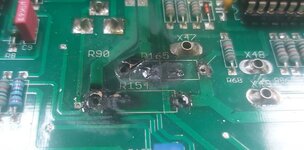eagle1109
Full Member level 6

- Joined
- Nov 20, 2014
- Messages
- 393
- Helped
- 4
- Reputation
- 10
- Reaction score
- 7
- Trophy points
- 1,298
- Location
- Saudi Arabia
- Activity points
- 5,956
Hi,
I'm doing some maintenance to training boards for power electronics. I want to know the type of this 4.7ohm resistor:

I want to purchase some from Aliexpress, but couldn't find the exact one. Is it an ordinary 4.7ohm, 2W resistor ?
When I searched about it with google lens I found results saying it's "Resistance Fusibles Métal Ohms 2 Watts".
Would something like this one be the same ?

I'm doing some maintenance to training boards for power electronics. I want to know the type of this 4.7ohm resistor:
I want to purchase some from Aliexpress, but couldn't find the exact one. Is it an ordinary 4.7ohm, 2W resistor ?
When I searched about it with google lens I found results saying it's "Resistance Fusibles Métal Ohms 2 Watts".
Would something like this one be the same ?




